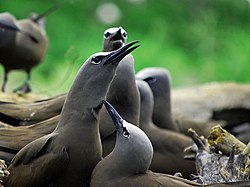Anous stolidus
| Brown noddy | |
|---|---|
 |
|
| Brown noddies nesting in Tubbataha Reef National Park in the Philippines. | |
| Scientific classification | |
| Kingdom: | Animalia |
| Phylum: | Chordata |
| Class: | Aves |
| Order: | Charadriiformes |
| Family: | Sternidae |
| Genus: | Anous |
| Species: | A. stolidus |
| Binomial name | |
|
Anous stolidus (Linnaeus, 1758) |
|
The brown noddy or common noddy (Anous stolidus) is a seabird from the tern family. The largest of the noddies, it can be told from the closely related black noddy by its larger size and plumage, which is dark brown rather than black. The brown noddy is a tropical seabird with a worldwide distribution, ranging from Hawaii to the Tuamotu Archipelago and Australia in the Pacific Ocean, from the Red Sea to the Seychelles and Australia in the Indian Ocean and in the Caribbean to Tristan da Cunha in the Atlantic Ocean. The brown noddy is colonial, usually nesting on elevated situations on cliffs or in short trees or shrubs. It only occasionally nests on the ground. A single egg is laid by the female of a pair each breeding season.
Anous is Greek for "unmindful" (Harrison, 1990; see also nous), and stolidus means "impassive" in Latin (see also stolid). The birds are often unwary and find safety in enormous numbers. To sailors, they were well known for their apparent indifference to hunters or predators.
There are four subspecies of the brown noddy:
Adult and chick
Brown noddy
Close-up of head.
Lady Elliot Island, Queensland
...
Wikipedia

